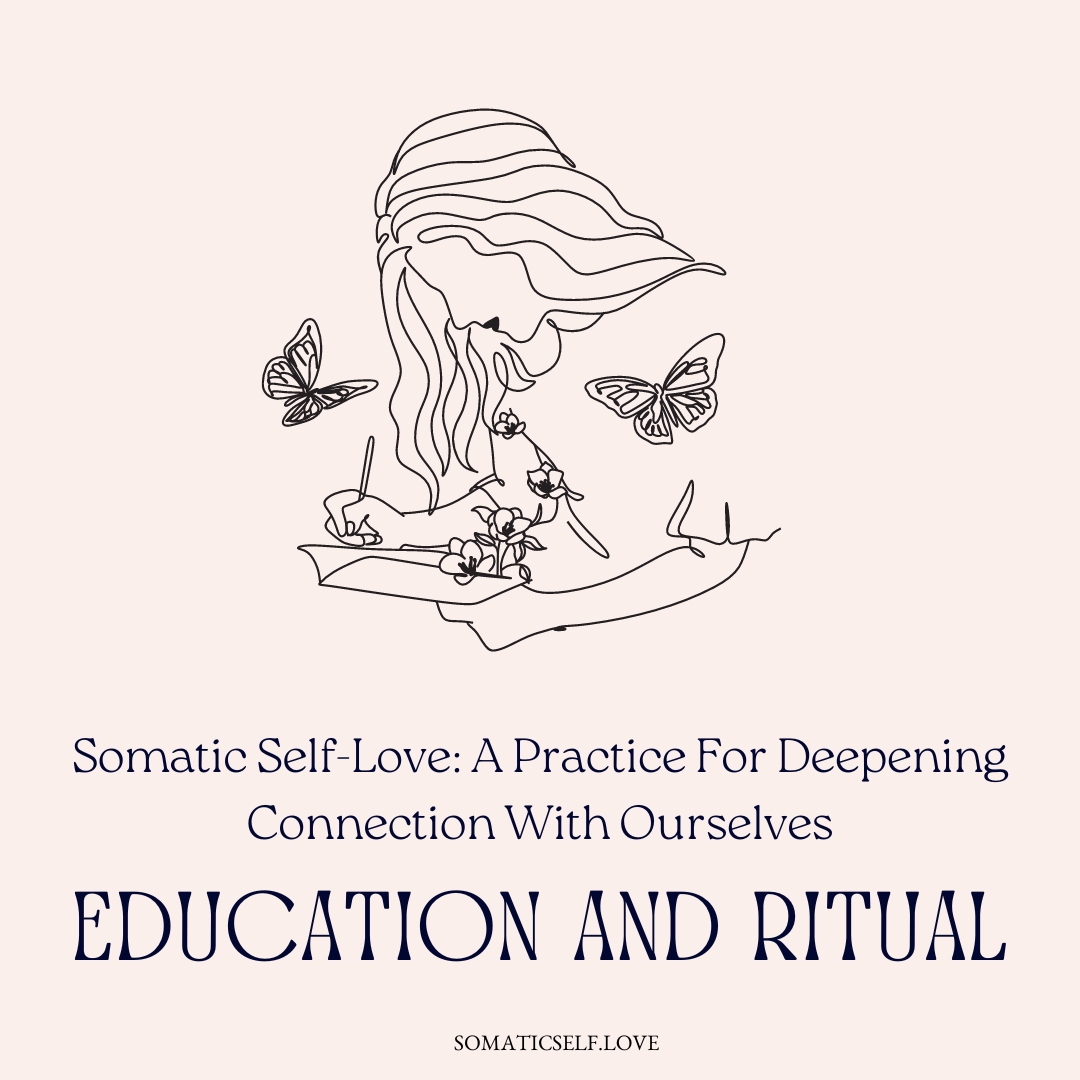Somatic Self-Love: A Practice For Deepening Connection With Ourselves

When I mention the term “somatic self-love,” I often see puzzled expressions. It’s a term not commonly encountered, yet it represents a concept so intrinsic to our well-being. And once people grasp what it means, the next question is invariably, “How do I cultivate it?”
Why is it so difficult for us to love ourselves? Why do we struggle to embrace who we are, in all our messy, imperfect, human glory? These are profound questions, ones I explore in depth in my upcoming book. But for now, let’s begin to unravel the concept of somatic self-love and discuss how we can nurture it within ourselves.
As beautifully stated by Louise L. Hay, “Remember, you have been criticizing yourself for years and it hasn’t worked. Try approving of yourself and see what happens.” Her words reflect a powerful truth: self-criticism seldom yields positive change. It’s time for a different approach.
What is Somatic Self-Love?
“Somatic” refers to the body separate from the mind, the physicality that we inhabit. Somatic self-love, therefore, involves forming a loving, compassionate relationship with ourselves through our bodies. It’s about acknowledging and accepting our bodies with all their sensations, vulnerabilities, strengths, and capabilities. It’s not just about how our bodies look, but how we feel within them.
Cultivating Somatic Self-Love: A Practice, Not a Destination
Cultivating somatic self-love isn’t about reaching a final destination, but about embarking on a continuous journey. It’s a practice, akin to mindfulness or gratitude, that we incorporate into our daily lives.
And, like any practice, it requires tools. In the case of somatic self-love, these tools can include rituals, breathwork, and community.
Rituals
Rituals provide a structured way to connect with our bodies and create a tangible, sensory link to the concept of self-love. One such ritual could involve journaling, where you write a compassionate letter to your body. Or, it could be a body scan meditation, where you mentally traverse your body, acknowledging each part without judgment. Creating your own personalized rituals that resonate with your experience is a powerful step towards cultivating somatic self-love.
Breathwork
Breathwork is a potent tool for grounding ourselves in our bodies. Our breath is a constant, reliable companion – it’s always with us, reflecting our emotions and states of being. Practicing intentional breathing can help us tune into our bodies, reminding us of the miraculous work our bodies do every moment to keep us alive.
Community
Community plays an essential role in our somatic self-love journey. Surrounding ourselves with supportive, understanding individuals can provide the motivation and reinforcement we need to continue our practice. Remember, you’re not alone in this journey. Sharing experiences and learning from others can be incredibly healing.
Embodiment of Self-Love: Creating a Felt-Sense
Our goal is to create a ‘felt-sense’ of self-love in our bodies. This means associating self-love with familiar sensations and experiences, making it easier to connect with this feeling in the future.

What does somatic self-love feel like, sound like, or look like to you? Is it a warm glow spreading from your heart? The gentle hum of a contented sigh? The vibrant color of a sunrise? The more deeply you can engage with these sensory experiences of self-love, the easier it will become to evoke and cultivate this feeling when you need it.
Remember, there’s no ‘right’ or ‘wrong’ way to imagine or practice somatic self-love. It’s a deeply personal experience that will look, feel, and sound different for everyone. Your journey towards somatic self-love is yours alone – and it’s one worth embarking on.
Compassion, Kindness and Love – For Ourselves
Somatic self-love is a transformative practice that can profoundly impact how we relate to ourselves. It asks us to extend the compassion, kindness, and love we so readily give to others to ourselves. And in doing so, we create a more nurturing, accepting, and loving relationship with the most enduring companion we’ll ever have – our own body.
Ritual: Naming the Felt-Sense of Self-Love in Your Body
Here’s a step-by-step guide to a Somatic Self-Love Ritual that involves naming the felt-sense of self-love. This ritual can be done once a week or as often as you find it helpful.
Materials Needed:
- A quiet, comfortable space
- A notebook or journal
- A pen or pencil
Steps:
- Set the Scene: Find a comfortable, quiet place where you won’t be disturbed. You may choose to light a candle, play some gentle music, or do anything else that helps create a soothing atmosphere.
- Ground Yourself: Close your eyes and take several deep breaths, focusing on the sensation of your breath entering and leaving your body. Feel your body in the space it occupies, the contact of your feet with the floor, or the weight of your body on the chair.
- Body Scan: Starting from your toes and working your way up to your head, mentally scan your body and notice any areas of tension or discomfort, as well as areas of ease or neutrality. Don’t judge or try to change these sensations, just notice them.
- Feel the Somatic Self-Love:
- Visualize: Close your eyes and visualize the concept of somatic self-love in your body. What does it look like? Is it a particular color? Does it have a shape or form?
- Engage Your Senses:
- Touch: What does somatic self-love feel like in your body? Is it a warm, soothing sensation, like a gentle hug, or does it feel more like a cool, calming breeze? Try to physically sense this in your body.
- Sound: If somatic self-love had a sound, what would it be? The soft rustle of leaves, a gentle hum, or perhaps the soothing sound of ocean waves?
- Taste: If you could taste somatic self-love, what would it be like? Sweet like honey, or fresh like a crisp apple?
- Smell: What would somatic self-love smell like? Perhaps it’s the comforting smell of fresh bread, or the invigorating scent of a forest after rain.
- Write About the Experience: Open your eyes and describe this multi-sensory experience of somatic self-love in your journal. Write about the color, shape, feel, sound, taste, and smell of somatic self-love as you’ve imagined it. Try to evoke the sensations you’ve visualized through your words.
- Express Gratitude: Open your eyes and begin to write in your journal. Start by expressing gratitude to your body. Thank each part of your body for the work it does to keep you alive and functioning.
- Acknowledge the Pain: If there are parts of your body that are holding pain or discomfort, acknowledge them in your writing. Write about what you feel in these areas and express your understanding and compassion towards them.
- Write a Letter of Compassion: Imagine that your body is a separate entity that you are writing a letter to. Write words of love, understanding, and compassion to your body.
- Affirmations: End the letter with some positive affirmations. These could be general affirmations of self-love and acceptance, or they could be specific to areas of your body that need healing or acceptance.
- Closure: Close your eyes again and take a few more deep breaths, imagining the words you wrote soaking into your body, providing healing and love.
- Regular Practice: Make a commitment to repeat this ritual regularly. The more frequently you practice, the deeper and more profound your connection with your body will become.
Remember, this is your ritual. Feel free to adapt it to suit your needs and preferences. The goal is to cultivate somatic self-love, so any changes that help you feel more in tune with your body and cultivate self-love are welcome.
Supporting Research
There is a body of research that supports the practice of self-love exercises, like writing a letter to oneself from a compassionate perspective. Here are a few examples:
- Neff, K. D., & Germer, C. K. (2013). A pilot study and randomized controlled trial of the mindful self‐compassion program. Journal of Clinical Psychology, 69(1), 28-44. This study found that a program designed to increase self-love, which included practices such as writing letters to oneself from a compassionate perspective, led to significant improvements in self-compassion, mindfulness, and well-being.
- Leary, M. R., Tate, E. B., Adams, C. E., Batts Allen, A., & Hancock, J. (2007). Self-compassion and reactions to unpleasant self-relevant events: The implications of treating oneself kindly. Journal of Personality and Social Psychology, 92(5), 887. This research provides evidence that self-compassionate people are less likely to avoid or suppress negative feelings about themselves, and are more likely to constructively confront their own weaknesses.
- Shapira, L. B., & Mongrain, M. (2010). The benefits of self-compassion and optimism exercises for individuals vulnerable to depression. The Journal of Positive Psychology, 5(5), 377-389. This study found that self-compassion exercises, including writing a self-compassionate letter to oneself for seven days, resulted in reductions in depression, rumination, and self-criticizing beliefs.
- Adams, C. E., & Leary, M. R. (2007). Promoting self–compassionate attitudes toward eating among restrictive and guilty eaters. Journal of Social and Clinical Psychology, 26(10), 1120-1144. This research demonstrated that writing a compassionate letter to oneself can reduce body dissatisfaction and unhealthy dieting behaviors.
While these studies don’t specifically focus on the somatic aspect of self-love, they provide evidence that exercises aimed at cultivating self-compassion and self-love can have significant positive impacts on mental health and well-being. Such exercises can be adapted to a somatic self-love framework by emphasizing the physical body and bodily sensations in the compassionate letter writing process.